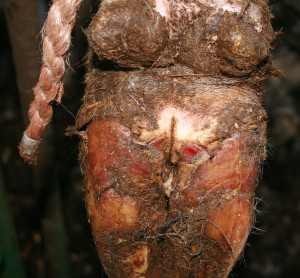Foot problems are one of the most serious welfare concerns facing the livestock industry today. In the UK cattle industry, digital dermatitis is a major cause of lameness and an increasingly serious problem. The disease can cause painful lesions on the skin around the hoof, as well as in other areas, including between the claws and on the udders of cows. It has also moved into sheep (known as contagious ovine digital dermatitis).
Mild digital dermatitis lesion on the bulb of a hind heel of a beef cow (from Sullivan and other 2013)
As well as negatively affecting animal welfare, digital dermatitis can adversely affect the productivity and profitability of farms. The National Animal Disease Information Service estimates that digital dermatitis costs, on average, £30 per cow per year in the UK. Affected cows produce less milk and have reduced fertility, and this accounts for the majority of economic losses due to the disease.
Clearly, digital dermatitis is a serious problem for the farming industry in the UK; it is therefore quite surprising that its epidemiology is not well understood.
A more severe digital dermatitis lesion (Sullivan and other 2013)
A relatively new disease, the condition was identified for the first time in Italy in 1974 and wasn’t seen in the UK until the late 1980s. It is known to be caused by certain species of bacteria of the Treponema genus.
When it comes to treatment, footbathing and antibiotics have been shown to have limited effects, and as yet there is no definitive cure. Furthermore, relatively little is known about how the causal pathogens are transmitted between animals.
In a paper recently published in Veterinary Record, a group of researchers from the University of Liverpool (in collaboration with Roger Blowey from the Wood Veterinary Group) aimed to investigate a potential route of transmission for the disease – hoof trimming equipment.
Hoof/foot trimming is a standard element of livestock care. It is generally recommended that both cattle and sheep undergo a foot examination and, if necessary, have their feet trimmed at least once a year. The University of Liverpool team hypothesised that digital dermatitis-causing bacteria could be hitching a ride from animal to animal via the equipment used for hoof trimming, and designed and conducted a study to test this theory.
Six farms (two beef, two dairy and two sheep farms) in Denbighshire, Monmouthshire and Gloucestershire were included in the study. While on routine farm visits, vets were asked to randomly select animals undergoing hoof trimming and to take a sample from the hoof trimming equipment after it had been used. After the first sample was taken, the equipment was rinsed in iodine disinfectant and a second sample was taken.
‘We sampled equipment after it had been used to trim a hoof to determine whether treponemes could adhere to the knife following trimming’, said Leigh Sullivan, one of the authors of the paper. ‘Equipment was also sampled after the knife had been disinfected so we could assess whether disinfection removed treponeme DNA from the knife.’
The researchers found that treponeme DNA was present on 36 out of 37 hoof trimming instruments tested (97 per cent). They then sought to establish whether this DNA was from Treponema species that were known to cause digital dermatitis. Using PCR techniques, they found DNA of digital dermatitis-causing bacteria in the majority of cases after trimming a digital dermatitis-positive animal.
Following disinfection, the number of instruments with treponemal DNA detected was reduced to 13 of 37 (35 per cent).
‘The high detection rate of digital dermatitis treponemes on hoof trimming equipment was unexpected,’ said Dr Sullivan. ‘It appears that after trimming a symptomatic foot, treponemes are consistently able to adhere to the metal of the equipment. Additionally, in some cases, treponeme DNA was found on equipment used to trim asymptomatic animals, which could mean that treponemes were present on the foot due to another environmental factor or, although not obviously symptomatic at the time, the animal had an undetected early lesion.’
The authors of the paper conclude that the transmission of digital dermatitis-causing bacteria from animal to animal via hoof trimming equipment could be ‘significant and worrying’. They also note that the routine disinfection method used was not always sufficient to remove all bacteria.
‘We understand from the data that this could be a contributing factor to the transmission of digital dermatitis,’ said Dr Sullivan. ‘However, other routes of transmission need to be explored to fully understand the spread of this disease.’
The authors note that this study does not prove that digital dermatitis is transmitted by foot trimming tools and that more research is needed. However, their results provide new information about the epidemiology of this important and pervasive condition.

